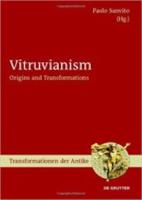
De Gruyter (2016) h/b 212pp £59.99 (ISBN 9783110377583)
In his de architectura Vitruvius ranges far from what we would consider the area of architecture. The work is both challenging and highly influential and thus a fertile ground for scholarship. It has been much interpreted, adapted or invented—and consequently disputed. The papers here examine various aspects of Vitruvianism or the reception of Vitruvius’s work, and some may be unexpected: in the ‘Polyperspectival Terminology in the Hypnerotomachia Poliphili’ Matteo Burioni looks at the author’s use of architectural terminology from Alberti, Vitruvius, and elsewhere. Some usages are surprising: metope ‘or front of the great portal’ is not from μετόπη but μέτωπον (face or front of a building), a usage traced to Herodotus rather than Vitruvius.
In contrast, Daniel Millette’s essay ‘Vitruvius and the Re-Invention of Classical Theatre Architecture’, examines in detail the excavation and restoration of the theatre of Orange. Although the scaenae frons is well preserved, the cavea is substantially restored, and accounts of the building don’t always acknowledge this. Bieber* for example mentions the ‘covered colonnade’ running round the upper rim, a feature which Millette reveals was first described in the 1830s from remains of uncertain date. Over 100 houses were gradually removed from the cavea, which thus emerged slowly. The temptation to reconstruct the seating in drawings was irresistible, and Vitruvius offered an authoritative model on which to base assumptions. Theory, then, seems to have contributed to the creation of a World Heritage Site ‘of universal value, protected for the benefit of humanity.’
In ‘Pliny the Elder: an Early Reader of Vitruvius’, Peter Fane-Saunders reveals considerable differences between the two authors’ principal interests and use of vocabulary, yet can conclude that of all Latin authors Pliny ‘did the most to perpetuate the Vitruvian tradition.’
This brief selection gives some idea of the variety of the eleven conference papers which make up this volume (only six are in English). The impressive range (from papers on architectural theory to Vitruvius’ image of the universe), well reflects the scope of the de architectura. The collection is ably edited by S., but there are rather too many typographical errors, at least one anacoluthon (‘The recent appearance … recently appeared.’ p. 2), a figure omitted and another occupying its place out of sequence.
Alan Beale
